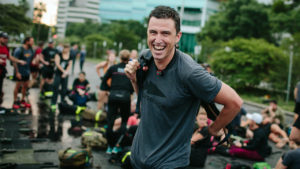Rucking
Does walking to lose weight sound appealing to you? As a coach who sees longevity in exercise as more important than six pack abs, I can’t help but be a major advocate for “rucking” to lose weight. Rucking by definition is purposefully marching – conditioning yourself to travel long distances on varied terrain, carrying weight for the express purpose of physical training. In this post I will highlight some key benefits of rucking in hopes of coaxing you into taking your fitness a step further.

The Benefits
Its Safe
Rucking is extremely safe for long term enjoyment, as long as you start slowly, don’t overload your pack, and pick hikes that are fit to your skill level. Like in most form of exercise, if you try to do too much at first, injury is likely. Ease into it increasing the load, and distance of the walk as your body is ready.
Be cautious about extreme terrain, unless you are fit for such traveling. Uneven terrains and elevated paths increase your chances of falling. Only travel these paths if you are confident in your balance and have good joint stability.
You Burn A Lot of Calories
With the additional weight added on, your body must work a lot harder to supply the blood needed to keep you in motion. For the average guy, a 30-minute walk burns about 125 calories, according to the Compendium of Physical Activities. But throw a 20lb weighted backpack on and take that exact same walk, and you burn about 325 calories, also according to the Compendium of Physical Activities.
You Get Outside
A long ruck can be beneficial in all seasons. With winter approaching rucking is a great way to get outdoor when staying inside seems like the most convenient thing to do. You will breath fresh air, get in touch with nature and you will stay warm while doing it. Give it a try, you won’t regret it
It Helps Build Your Endurance
When walking with extra weight you will find your heart rate climbs up quickly, and remains up for the entirety of the exercise. Rucking turns your lazy walk into a heart health boosting endurance endeavor.
“The cardio benefits of rucking are comparable to those gained from other long, slow distance exercises like jogging,” says Jason Hartman, C.S.C.S. who trains Special Forces soldiers for the US Military.
But unlike jogging—which has an injury rate anywhere from 20 to 79 percent, according to a study in the British Journal of Sports Medicine—rucking actually makes you more injury resilient, says Hartman.
“It builds up your hip and postural stability, and that makes you more injury proof in all your other activities,” he says.
How To Do It
1. Choose your load
A good place to start for general fitness is to use a weight that’s equal to about 10 percent of your total bodyweight. For example, if you weigh 150 pounds, load your pack with about 15 pounds.
Don’t stress too much about going above or below by a pound or two—just stay in the general ballpark.
Once you’re comfortable, you can progress up to 35 pounds.
“You can go with 35 pounds on your back for days, months, years,” “But once you start to sneak above 35 pounds, it can break down your body.” An expert cautions
2. Load the pack
For weight, you could throw a dumbbell in your pack. Or you can even use a couple of bricks or a sand bag. If you feel like getting fancy, various online sites offer weight plates specifically designed for rucking. I also recommend purchasing a weight vest since you can easily adjust the weight, and the vest secures to your body safely.
3. Ruck!
Now, toss on your pack and go for a walk or hike. You can go as long and far as you want. But when you’re just starting, it’s best to ease into the activity. Listen to your body, if joints get sore, and you start feeling blisters forming on your feet, its time to call it a day.

